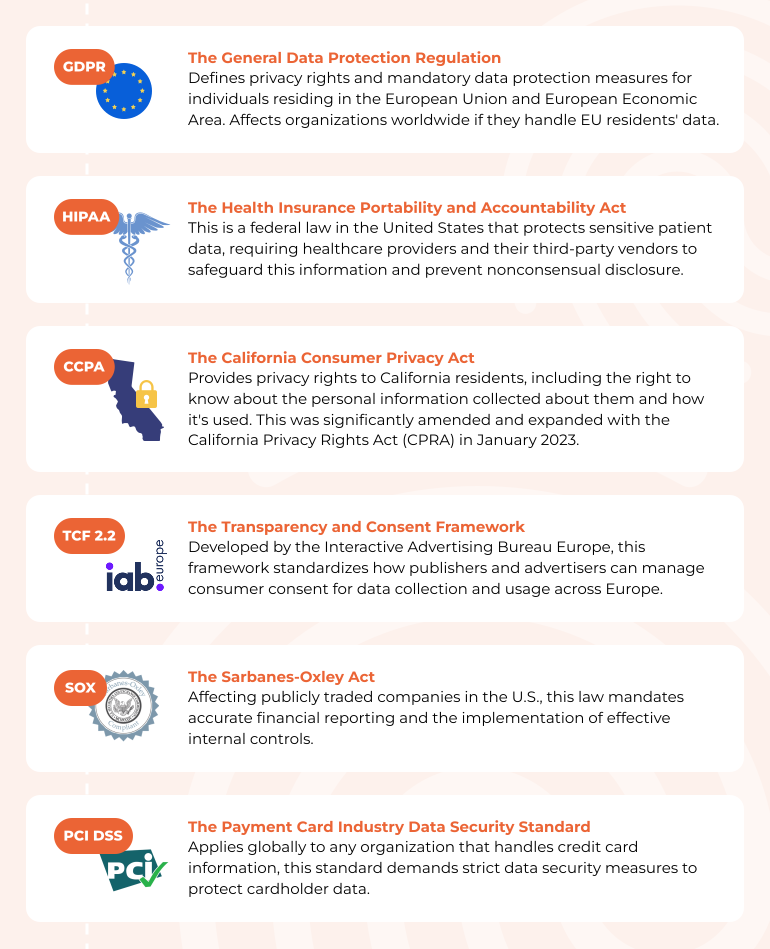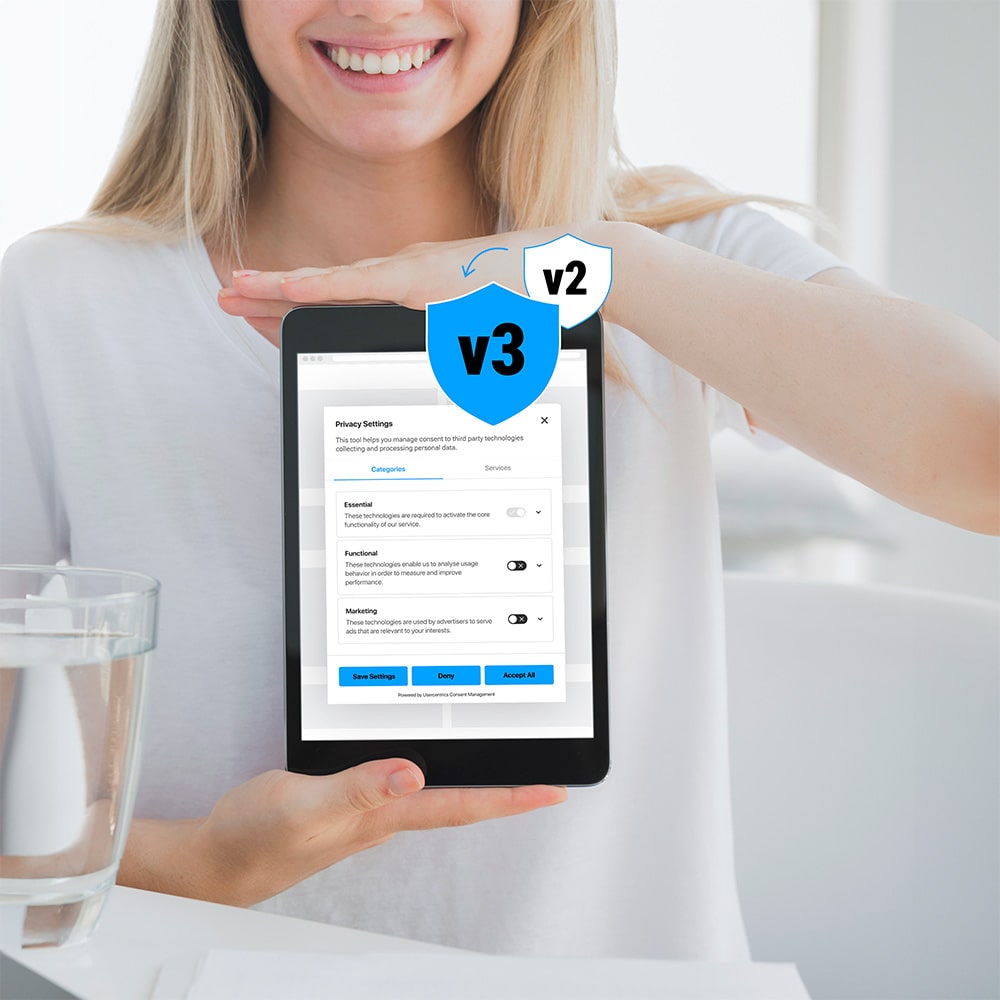Navigating IT compliance is vital for businesses in today’s digital world. With so many business processes running on cloud-based platforms, legislators are increasingly attentive to who has access to sensitive data, how it’s handled, and which IT security measures are in place to protect it.
As a consent management platform (CMP) provider, Usercentrics keeps up to date with IT compliance requirements. After all, we provide software that helps our clients ensure these legal requirements are met.
We’ve drawn upon these insights to create this essential guide, where you’ll find the tips, standards, and insights you need to understand and navigate the complexities of IT compliance.
What is IT compliance?
IT compliance refers to the requirement for an organization’s IT systems and processes to meet security, regulatory, and contractual standards.
To meet and maintain IT compliance standards, you must ensure all your technology processes and systems, and data management strategies, align with both industry standards and the legal requirements outlined in regulations for every region where you operate.
Some regulations are also extraterritorial. They apply, for example, to the personal data of users in a specific region, and thus require your regulatory compliance if you process that data, even if your company is not located in that region.
While exact regulatory requirements can vary, the overarching goal is typically to protect the data and privacy of customers and employees, and to maintain data integrity and security across the board.
Why is IT compliance important?
“IT compliance means following the rules and regulations related to technology and data. It involves making sure that a company’s systems and processes meet legal requirements and industry standards.
This could include things like protecting customer information, keeping systems secure from hackers, and following guidelines for how data is stored and used.
In Usercentrics, as a certified ISO27001 and TISAX company, we have implemented all the possible arsenal of required concepts, controls, and policies to ensure that all the scopes are covered and controlled in the most efficient way.”
— Ludovic L’Hoir, Usercentrics Sr. Manager IT Operations & IT Compliance
While compliance requires ongoing work and investment, its benefits far outweigh the costs, and mitigate risks. Here’s why achieving and maintaining IT compliance is so important:
- Legal and regulatory compliance reduces the risk of fines, other legal penalties, and loss of brand reputation.
- Robust compliance standards enhance data security, safeguard against data breaches, and protect sensitive information.
- Communicating compliance status builds and maintains consumer trust.
- Evolving legislation is a helpful benchmark to ensure your IT systems and strategies are resilient and up to current standards.
IT compliance vs IT security
IT compliance focuses on ensuring that an organization’s IT systems and practices meet legal and regulatory standards, often involving policies, procedures, and documentation to prove adherence.
IT security, however, is more technical and practical, concentrating on protecting IT systems, data, and networks from cyber threats, unauthorized access, and data breaches. While IT compliance is about meeting specific standards set by external bodies, IT security is about actively defending against threats and vulnerabilities.
“IT compliance is about following rules and regulations, like laws and industry standards, to make sure everything is legal and meets requirements. It’s like making sure you’re following the speed limit while driving.
On the other hand, IT security is about protecting computer systems and data from being hacked or accessed by unauthorized people. It’s like locking your doors at home to keep burglars out.
So, while IT compliance focuses on following the rules, IT security focuses on keeping everything safe from potential threats. They’re related because security measures are part of IT compliance, but they’re not the same thing.
Compliance is about meeting specific guidelines, while security is about protecting against potential dangers.
In Usercentrics as a certified ISO27001 and TISAX company we have implemented specific concepts and controls related to IT security, including but not limited to regular pentests, encryptions, and security through EDR.” — Ludovic L’Hoir, Usercentrics Sr. Manager IT Operations & IT Compliance
Do you need to worry about IT compliance?
From mobile gaming to financial services, if your organization uses digital technologies and manages data, regardless of size or industry, then you need to be concerned about IT compliance.
That said, the degree and complexity of legal requirements will depend on the sector and type of organization. For instance, if your company deals with critical infrastructure — like energy, transport, and water supply — the stakes of compliance are especially high, so your requirements will be uniquely strict and complex.
“IT compliance is important for any business that deals with sensitive data, no matter what they do or how big they are. By following these rules, companies protect people’s information, follow the law, and earn the trust of customers and others who rely on them,” says Ludovic L’Hoir, Usercentrics Sr. Manager IT Operations & IT Compliance.
“For example, companies like Usercentrics, which work with people’s data, follow rules like GDPR, ISO27001, and TISAX to show customers they take data security seriously and can be trusted.”
But even the smallest startups aren’t exempt from the watchful eye of regulators and must navigate laws and industry standards to ensure data protection, security, and integrity within their IT systems and processes.
“Compliance helps prevent problems like data breaches, protects people’s privacy, and avoids legal trouble,” L’Hoir states.
IT compliance regulations
To navigate IT compliance effectively, businesses need to stay up to date with all rules and regulations that apply to the regions where their customers and employees are based, as well as relevant business practices. Some key laws include:
- The General Data Protection Regulation (GDPR): Defines privacy rights and mandatory data protection measures for individuals residing in the European Union and European Economic Area. Affects organizations worldwide if they handle EU residents’ data.
- The HIPAA (Health Insurance Portability and Accountability Act): This is a federal law in the United States that protects sensitive patient data, requiring healthcare providers and their third-party vendors to safeguard this information and prevent nonconsensual disclosure.
- The California Consumer Privacy Act (CCPA): Provides privacy rights to California residents, including the right to know about the personal information collected about them and how it’s used. This was significantly amended and expanded with the California Privacy Rights Act (CPRA) in January 2023.
- The Transparency and Consent Framework (TCF 2.2): Developed by the Interactive Advertising Bureau Europe, this framework standardizes how publishers and advertisers can manage consumer consent for data collection and usage across Europe.
- The Payment Card Industry Data Security Standard (PCI DSS): Applies globally to any organization that handles credit card information, this standard demands strict data security measures to protect cardholder data.

Top tip: Check if your mobile app is compliant with the Usercentrics Mobile Apps SDK.
Minimize legal risk with a consent management platform (CMP)
A lot goes into ensuring IT compliance. Usercentrics CMP streamlines processes by ensuring your digital properties meet key legal requirements. More specifically, the CMP makes it easy to obtain, securely store, manage, and signal valid user consent in line with legal standards in the GDPR and CCPA/CPRA, among other regulations, and business requirements from large digital platforms.
By automating various processes related to user consent, you can rest assured that all potential gaps and blind spots are covered — without having to deal with the significant time and resource requirements to manually ensure compliance.
Usercentrics CMP has an extensive feature set that enables customization of your implementation to the legal context of your business, industry, and geography.
It also integrates with many popular web platforms and marketing tools that handle functions from analytics to retargeting. And it works with your tech stack to protect data and boost marketing performance, enhancing campaigns with personalization and other features while following best practices for data security.
U.S. compliance deep dive: Learn more about U.S. state-level data privacy laws
How Usercentrics prioritizes IT compliance
Usercentrics prioritizes IT compliance through comprehensive data management and security measures.
- Data types and processing purposes: Usercentrics CMP enables companies to notify users about and obtain consent for personal data collection and processing via cookies and other tracking technologies at a granular level. This can include everything from account activity to IP address to contact information. Users can grant or deny consent to their preferred degree of granularity and easily change or revoke it at any time, in compliance with consent requirements of various international data privacy laws.
- Data ownership: The customer retains ownership of their data, with permissions for its collection and use clearly defined. In the event of a data subject access request, Usercentrics provides the user with a copy of their consent-related data, which is also theirs. Usercentrics’ Terms & Conditions lay out the contractual terms of our access to data, among other stipulations.
- How customers retrieve their data: Customers can make a data subject access request via the contact details and method outlined in our Privacy Policy. Any data requested is securely delivered only to the authorized and verified user.
- Data deletion timeline: Data is automatically deleted after a 12-month retention period. The consent data collected by a company is also deleted if their account is terminated. Backup files are encrypted.
- Controlled data access: Customers ultimately control who has access to their data online, and Usercentrics CMP helps to facilitate those permissions for data processing on websites, apps, and other connected platforms.
- Login authentication: Authentication is always performed via username and password, with optional two-factor authentication available on request. The two variants for the login authentication are a federated login via Google, or via the Auth0 authentication service.
- Data transmission and encryption: Data is transferred using HTTPS encryption (TLS 1.3). Data in idle mode is encrypted using AES256, with different codes used for each respective data packet.
- Data separation and storage: A customer-specific Settings ID logically separates data between unique customers in the database. Data from different categories is stored in separate databases with individual access keys.
- Service interruption protocol: Usercentrics has multi-stage recovery processes for service interruptions, with alert systems that ensure rapid response from our technical team.
Achieving and maintaining IT compliance is a non-negotiable. If your business handles user data, you must ensure your technology processes and systems are up to current standards, and are compliant with international regulatory standards.
Despite the many regulations, technologies, and cyber threats that impact IT compliance, your business can set itself up for success — by using the right tools and technologies.
Usercentrics prioritizes IT compliance through comprehensive data management and security measures. From granular consent management to controlled data access and encryption, our software helps you ensure IT compliance. Speak to a Usercentrics expert today.



